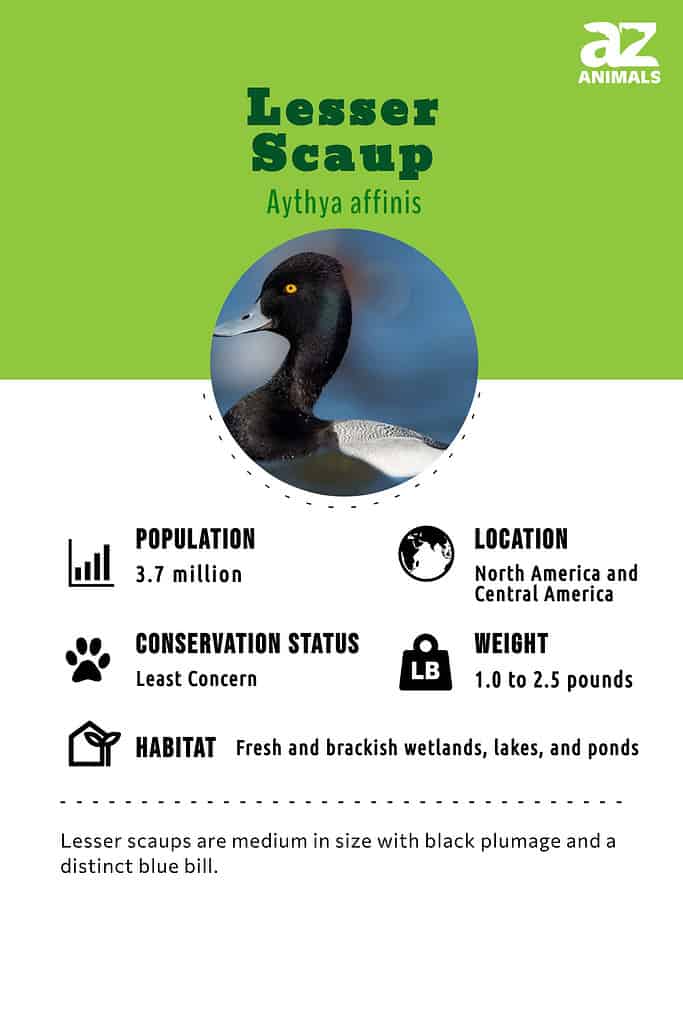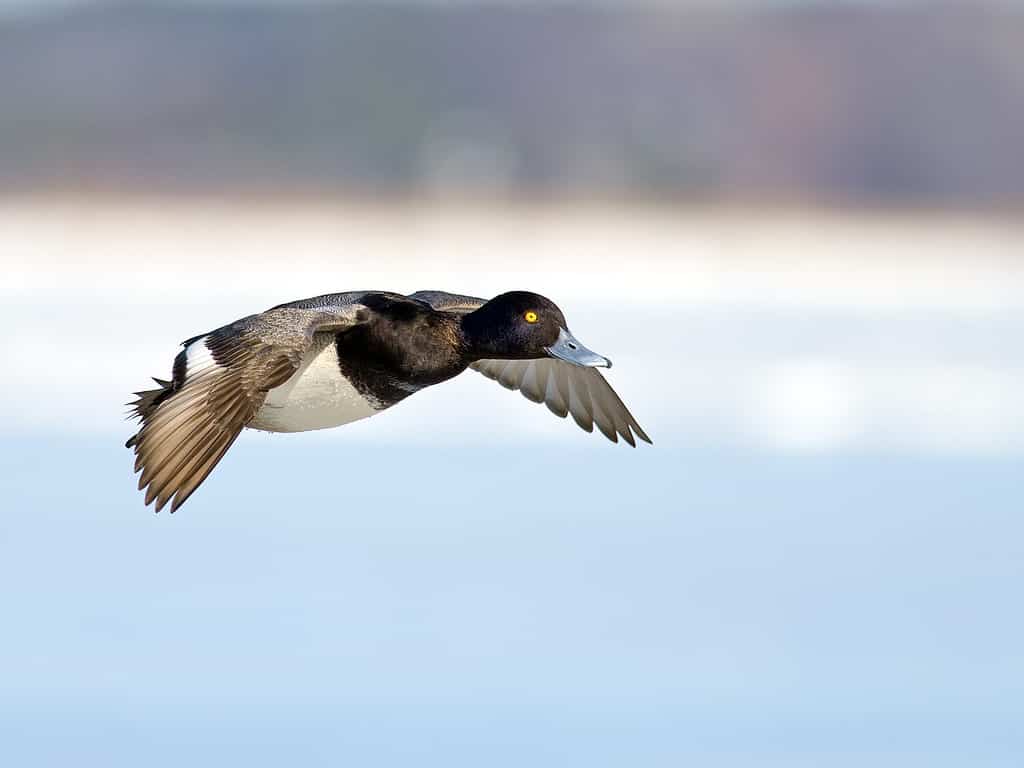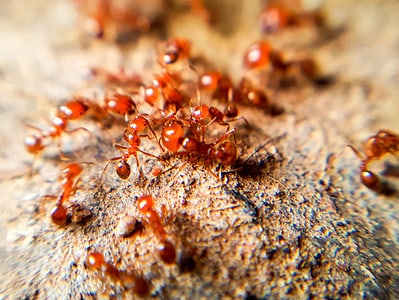Lesser Scaup
Aythya affinis
Young lesser scaups learn to dive as soon as their down dries.
Advertisement
Lesser Scaup Scientific Classification
- Kingdom
- Animalia
- Phylum
- Chordata
- Class
- Aves
- Order
- Anseriformes
- Family
- Anatidae
- Genus
- Aythya
- Scientific Name
- Aythya affinis
Read our Complete Guide to Classification of Animals.
Lesser Scaup Conservation Status
Lesser Scaup Facts
- Prey
- Mollusks and aquatic vegetation
- Main Prey
- Mollusks
- Name Of Young
- Chicks
- Group Behavior
- Flock
- Fun Fact
- Young lesser scaups learn to dive as soon as their down dries.
- Estimated Population Size
- 3.7 million
- Biggest Threat
- Climate change
- Most Distinctive Feature
- Blue bill
- Other Name(s)
- Little bluebil
- Wingspan
- 27 to 21 inches
- Incubation Period
- 21 to 27 days
- Diet
- Omnivore
- Lifestyle
- Flock
- Origin
- North America
- Average Clutch Size
- 10
- Nesting Location
- On the ground
- Migratory
- 1
View all of the Lesser Scaup images!
Lesser Scaup Summary
Young lesser scaups learn to dive as soon as their down dries.
The lesser scaup is a medium-sized diving duck. They are often seen forming groups with other species of diving ducks, such as canvasbacks and the greater scaup. Spending some of their earliest moments on the water, lesser scaups will sleep, eat, and socialize on the water. Unlike dabbling duck species, they can dive up to several feet underwater to secure their prey.
Lesser Scaup Amazing Facts
- Of all the duck species to migrate, the lesser scaup is often one of the last to make the move either north or south.
- They can be found in almost all types of waters, including coastal bays and estuaries.
- Their habitats range from as far north as Alaska down into South America.
- These ducks typically migrate at night.

Where to Find Lesser Scaups
Lesser scaups can be found throughout the western hemisphere. During their breeding season, they can be found in the far northern region of North America, including in Alaska. Outside of the breeding season, they live in the southernmost region of the United States, Mexico, Central America, and the Caribbean. They can be seen throughout the rest of the United States during their migratory period, and there are a few year-round populations in the United States and Venezuela.
During the breeding season, they prefer fresh and brackish wetlands. However, they favor any water source during the rest of the year. This includes common freshwater sources like lakes and ponds as well as coastal waters.
Lesser Scaup Nests
Lesser scaups will make their nests on the ground. They prefer to nest along tall vegetation in prairies and wetlands. Sometimes, females will choose to build their nests on floating platforms. No matter where they build it, however, they will always ensure that they conceal their nests well among the vegetation.
In order to build their nests, female lesser scaups will make a small depression in the ground. This will serve as the foundation for the nests. Then, they will begin to add grass and other plants, as well as down feathers.
Sometimes, you may see a half-completed nest with eggs. This is because female lesser scaups will lay their eggs before finishing the nest, and then they will finish the nest around their brood.
Lesser Scaup Scientific Name
The lesser scaup is in the class of Aves. There are in the Order Anseriformes and Family Anatidae. Their genus name is Aythya. This includes twelve different species of ducks. Their scientific name is Aythya affinis.
Their genus name is derived from the ancient Greek word aithuia. This is an unidentified seabird that appeared in many of the popular writings of the time period. Their species name comes from the Latin affinis, or related to, because of their similarities to the greater scaup.
Lesser Scaup Size, Appearance & Behavior

Lesser scaup have a wingspan of 27 to 31 inches.
©Brian E Kushner/Shutterstock.com
Adults grow 15 to 19 inches long on average. They can weigh 1.0 to 2.5 pounds, with males typically being heavier than females in the species. Their wingspan is 27 to 31 inches.
Adult males have dark black plumage. They have some white markings along their wings and backs. You can identify females by their brown coloration and the thick wide band at the base of their bills.
This species is also known as the little bluebill or just broadbill. This is because they have a distinctive blue bill.
They are not extremely vocal, especially compared to species of dabbling ducks. However, males do have distinct mating calls, with females having similar responses. As a result, mating time is typically the loudest season for these ducks, especially as their young come into the world with their own calls. Their name comes from the female’s call, which sounds like scaup, scaup.
Migration Pattern and Timing
Lesser scaups are some of the last ducks to migrate each season, both to and from the breeding grounds. They are nighttime migrators who tend to only travel a medium distance each year.
Most populations will spend the winter months around the Gulf of Mexico. However, there are some individuals who prefer to migrate further south.
Lesser Scaup Diet
Like many other species of diving ducks, they are omnivorous. The majority of their diet consists of aquatic invertebrates. However, they will also eat aquatic seeds and plants. Although they dive for their food, they usually forage in waters less than sixteen feet deep.
What does the lesser scaup eat?
This duck will eat mussels, clams, leeches, insects, and snails. The main plants in the vegetative portion of their diet are aquatic sedges and grasses.
Lesser Scaup Predators and Threats
Lesser scaups and their nests are vulnerable to many different threats, including predation. In recent years, they have faced a decline in population. However, while they are many theories as to the cause of this decline, there have been no studies able to confirm these. Some of the probable causes include climate change, hunting, limited resources during migration, and changes in geography.
There are also many predators for adult, young, and unborn individuals. These may vary based on the area that the individual settles, but many are present nonetheless.
What eats the lesser scaup?
One of the most notable predators of the lesser scaup is the red fox. This species will prey on adults, young, and eggs in the nest. They will also hunt adults outside of breeding season whenever they come ashore. Predators on land include snakes, raccoons, and mink. They may also fall prey to other birds, such as red-tailed hawks and owls.
Lesser Scaup Reproduction, Babies, and Lifespan
Lesser scaups are monogamous throughout the season, although they may find a different mate the next year. Once they navigate to the breeding ground and build their nest, they will typically have only one brood. These broods will contain anywhere from six to 14 eggs.
Each egg is around 2.2 inches long and 1.5 inches wide. The shell is pale olive to slightly green in color.
The incubation period lasts from 21 to 27 days. Once hatched, the young will be born with down and their eyes open. They are ready to leave the nest within 24 hours.
Lesser Scaup Population
There are around 3.7 million lesser scaup individuals in the world. Although their population has declined, there are measures put into place to help protect this species. This includes the Conservation Reserve Program (CRP), which is working to protect nesting habitats.
View all 98 animals that start with LLesser Scaup FAQs (Frequently Asked Questions)
Do lesser scaups migrate?
Yes, lesser scaups migrate twice a year. They spend breeding season in the northern part of their range and winters in the south.
How many eggs do lesser scaups lay?
They lay one brood per season. A single brood can have over half a dozen to a dozen eggs.
How fast do lesser scaups fly?
Lesser scaups are designed for swimming and diving. Though their speeds have not been recorded, they are rather slow compared to other species.
What is the lesser scaup's wingspan?
Their wingspan measures on average 27 to 31 inches long.
When do lesser scaups leave the nest?
Lesser scaups can leave the nest within the first twenty-four hours of life.
Thank you for reading! Have some feedback for us? Contact the AZ Animals editorial team.
Sources
- , Available here: https://www.fsa.usda.gov/programs-and-services/conservation-programs/conservation-reserve-program/

















